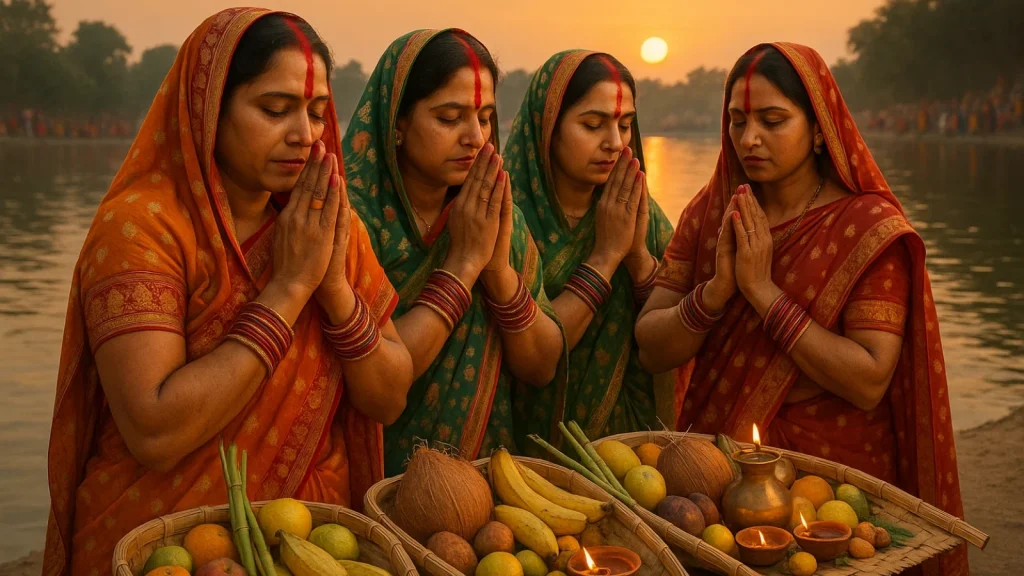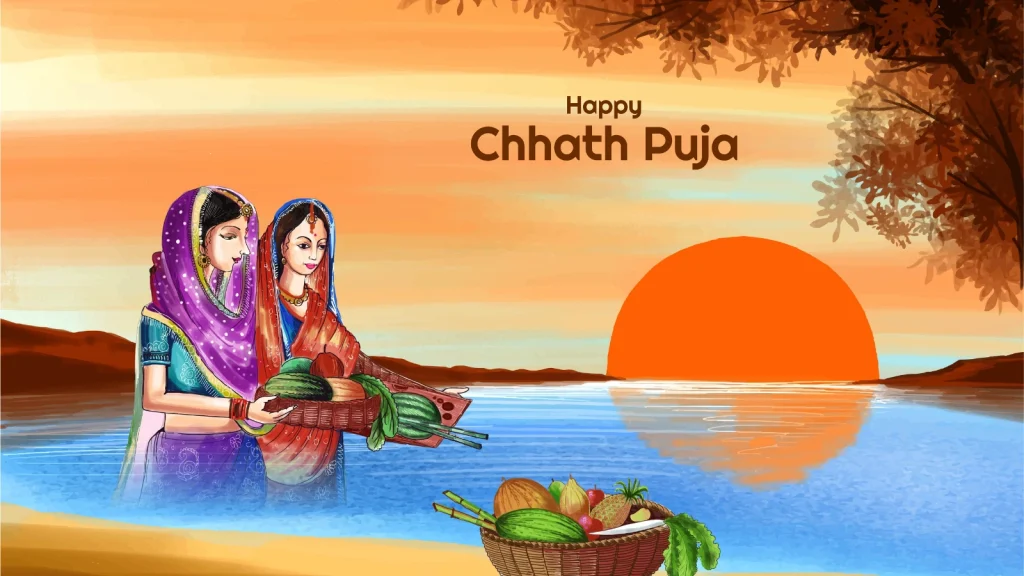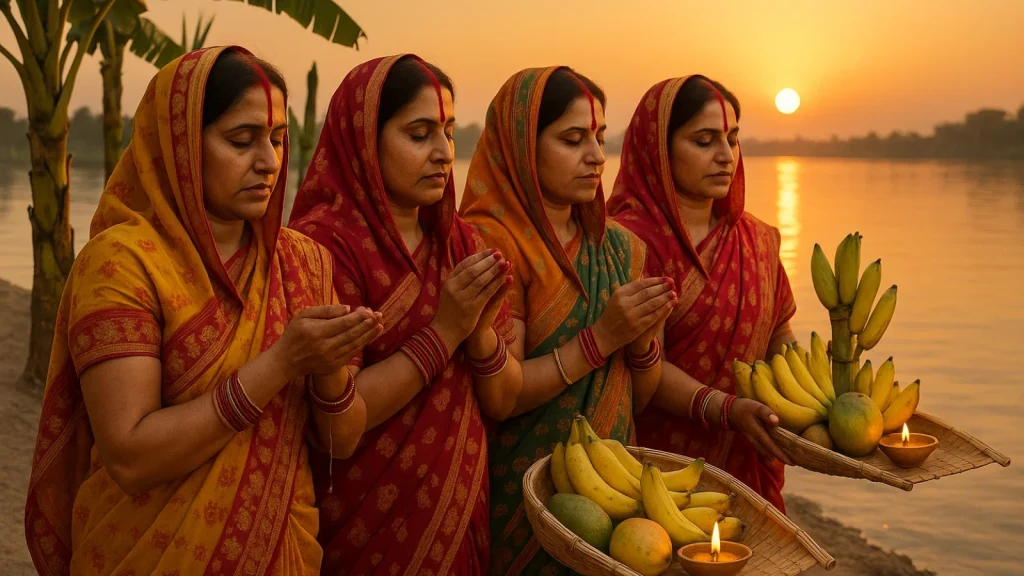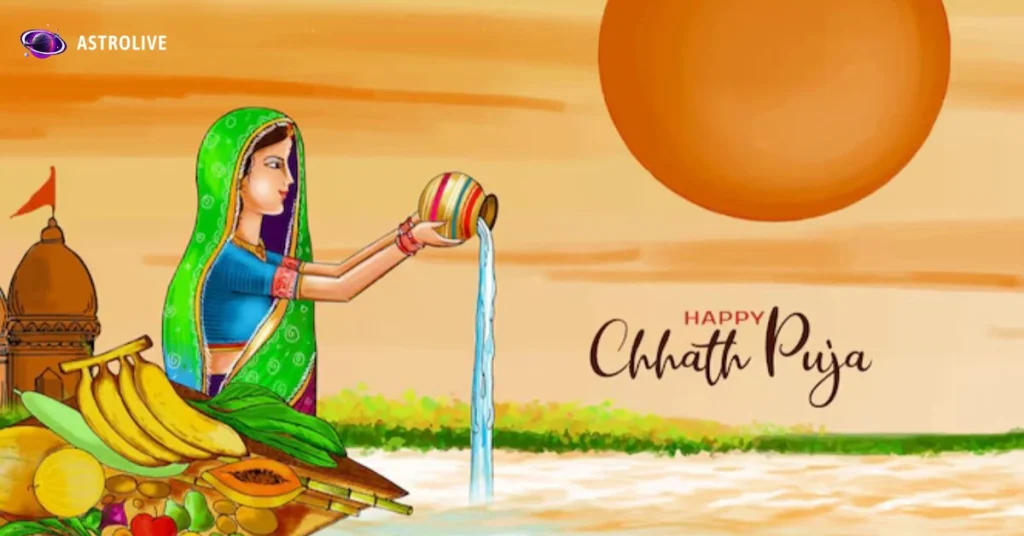India is known for its diverse festivals, each carrying deep spiritual, cultural, and social meanings. Among them, Chhat Puja holds a unique place as a celebration dedicated to the Sun God, Surya, and Chhathi Maiya. It is not just a festival but a heartfelt expression of gratitude, faith, and devotion observed mainly in states like Bihar, Jharkhand, and Uttar Pradesh, as well as in Nepal.
This festival emphasizes purity, discipline, and a direct connection between humans and nature. Unlike other Indian festivals, this Puja does not involve idol worship. Instead, it revolves around offering prayers to the setting and rising sun, symbolizing the cycle of life and energy.
What Is The Historical Background Of Chhat Puja?
The roots of Chhat Puja can be traced back to ancient Vedic traditions. References to sun worship are found in Rigveda, where rituals and hymns describe the power of Surya, who sustains life on earth. Some legends also connect the origin of this festival to Draupadi and the Pandavas in the Mahabharata, who observed sun worship to overcome challenges in their life.
Another popular belief links it with Lord Rama and Goddess Sita. After returning from exile, Sita is said to have performed this ritual to express gratitude and seek blessings for prosperity. Over centuries, these traditions have blended to form the festival we see today, symbolizing devotion and ecological harmony.
What Is The Deeper Importance Of Chhat Puja In Devotees’ Lives?

The essence of छठ पूजा lies in worshipping the sun, which represents health, vitality, and longevity. Devotees believe that offering gratitude to Surya brings prosperity, cures ailments, and ensures family well-being. The worship of Chhathi Maiya, believed to be a form of Usha (the goddess of dawn), signifies fertility and the nurturing aspect of life.
A unique aspect of this festival is that it is the only ritual where devotees worship the sun in both its forms, at the time of rising and at the time of setting. This dual worship reflects balance in life, gratitude for new beginnings, and respect for endings.
Another striking aspect of the festival is its eco-friendly nature. The rituals are performed along riverbanks, ponds, or natural water bodies, strengthening the bond between humans and the environment. By using clay vessels and offering natural fruits and grains, the celebration promotes sustainability in every form.
What Are The Rituals And Observances Of Chhat Puja?
The rituals of Chhat Puja are performed with great discipline, often extending over four days. Each day carries its own meaning and significance:
1. Nahay Khay (Day 1)
The first day marks purification. Devotees take a holy dip in rivers or ponds and prepare a simple meal, usually made in clay utensils. This meal is considered pure and free from garlic or onion, symbolizing spiritual cleansing.
2. Lohanda and Kharna (Day 2)
On the second day, devotees observe a full-day fast, which is broken after sunset with offerings of kheer (rice pudding), fruits, and chapati. This ritual strengthens discipline and prepares the body and mind for the following day’s fasting.
3. Sandhya Arghya (Day 3)
This is the most important day of Chhat Puja. Devotees fast without water and gather on riverbanks in the evening to offer “Arghya” (water and prayers) to the setting sun. The sight of thousands of lamps, chants, and offerings creates a divine atmosphere, showcasing unwavering devotion.
On this day, thekua (Sweet Dish) is also prepared and offered as part of the rituals, kept untouched until the offering, highlighting its sacredness.
Anyone who wishes to perform Chhat Puja for the better health of their children and husband can take guidance from experienced astrologers. If you want to know the correct chhath puja vidhi and its deep significance, you can connect with trusted astrologers at Astrolive for personalized advice.
4. Usha Arghya (Day 4)
On the final day, devotees return to the riverbank before sunrise to offer prayers to the rising sun. This ritual symbolizes the cycle of life, renewal, and gratitude for energy and light. After the offering, devotees break their fast, completing the festival.
These rituals are not just religious acts but spiritual disciplines that connect individuals directly with nature and the cosmos.
Also Read: How To Celebrate Karwa Chauth 2025: Rituals & Fasting Guide
When Is Chhath Puja 2025?
Wondering about the exact dates for Chhat Puja 2025? Here’s a clear guide so you can plan your rituals and celebrations in advance:
- Start Date: Saturday, 25 Oct 2025
- End Date: Tuesday, 28 Oct 2025
- Duration: 4 days of fasting, prayers, and rituals
This timeline covers all the key days, from Nahay Khay to Usha Arghya, ensuring you don’t miss any important observances. Knowing Chhath Puja Kab Hai helps devotees organize their preparations, offerings, and community participation perfectly.
Check Auspicious Timings With Today’s Panchang
Why Is Fasting Considered Significant In Chhat Puja?

Fasting during Chhat Puja is considered one of the toughest among Indian festivals. Devotees often abstain from even drinking water for long hours. This practice is not just about devotion but also a way to cleanse the body and mind. The strict discipline followed in these rituals highlights the depth of faith and the importance of self-control.
Apart from spiritual purification, fasting during the festival is believed to strengthen the bond with nature and the sun. By aligning meals and prayers with sunrise and sunset, devotees cultivate awareness of natural rhythms, promoting physical well-being, mental clarity, and a sense of gratitude for the life-sustaining energy of Surya.
What Is The Scientific Relevance Of Chhat Puja?
Interestingly, the practices of Chhat Puja also carry scientific reasoning. Offering prayers to the setting and rising sun allows the body to absorb solar energy at a safe time, improving immunity and promoting overall well-being. The act of standing in water during rituals has therapeutic effects, believed to detoxify the body and enhance energy flow.
Moreover, the consumption of sattvic food prepared during the festival helps in balancing the body’s metabolism.
If you are curious about how these rituals balance spiritual and scientific benefits, expert astrologers at Astrolive can guide you with accurate insights into traditions, health benefits, and the right way to perform each step.
Also Read: How To Celebrate Bhai Dooj 2025: Date, Rituals & Traditions
How Do Devotees Prepare For Chhat Puja?
The preparations for Chhat Puja begin days in advance. Families clean their homes, buy groceries, fruits, and other essentials, and arrange for eco-friendly baskets to carry offerings. Community participation is also vital, with local authorities and volunteers ensuring the cleanliness of water bodies and smooth arrangements for devotees. These collective efforts reflect the spirit of unity and devotion.
In addition to physical preparations, devotees also prepare mentally and spiritually. Many engage in prayers, meditation, and reflection to cultivate patience, discipline, and gratitude before the festival begins. This inner preparation complements the external arrangements, making the festival a holistic celebration of faith, devotion, and harmony with nature.
How Does Chhat Puja Promote Social Harmony And Community Unity?

One of the most beautiful aspects of छठ पूजा is inclusivity. It is not restricted to caste, class, or gender. Anyone with devotion can perform the rituals. This inclusiveness fosters social harmony, bridging gaps and strengthening community ties.
During the festival, people from different backgrounds come together to celebrate छठ पूजा. Families, neighbors, and communities unite at riverbanks and ghats, sharing in the preparations and rituals. This unity and collective participation are some of the reasons why the festival continues to grow in significance across regions.

Conclusion
Chhat Puja is more than just a festival, it is a journey of faith, gratitude, and discipline. Rooted in ancient traditions yet highly relevant in modern times, it unites people with nature and reinforces the values of sustainability and simplicity.
As devotees gather on the riverbanks, with lamps glowing and chants filling the air, the festival paints a picture of spiritual devotion that transcends boundaries. The practice of offering prayers to both the setting and rising sun beautifully symbolizes the balance of life, endings and new beginnings.
If you want to perform छठ पूजा in the most authentic way, or seek blessings for your family’s health, guidance from professional astrologers at Astrolive can make your devotion more meaningful. They help you understand the right rituals, timings, and remedies that ensure divine blessings.
Through its rituals, stories, and cultural significance, Chhat Puja continues to inspire generations, reminding us of the eternal bond between humans and nature.
FAQs
1. Can men perform Chhat Puja rituals too?
Ans. Yes, while traditionally women perform most of the rituals, men can also actively participate or perform the pooja themselves. Devotion and adherence to the rituals are more important than gender.
2. What are the best offerings for Chhat Puja?
Ans. Common offerings include thekua (sweet wheat biscuits), fruits, rice, and sugarcane. Devotees also offer water to the setting and rising sun using clean, clay vessels, emphasizing purity and simplicity.
3. Can Chhat Puja be celebrated at home if there’s no river or pond nearby?
Ans. Yes, while riverbanks are preferred, devotees can celebrate at home using clean water containers or small artificial water bodies. The key is maintaining purity, fasting, and devotion while performing the rituals.







